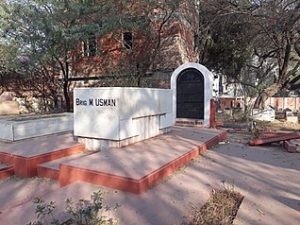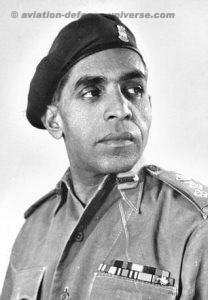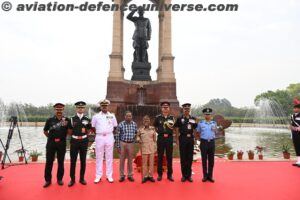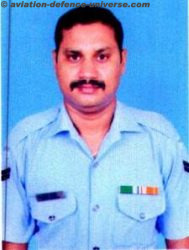- Nation salutes he who preferred India & Indian Army when most crossed over the Wagha border

New Delhi. 03 July 2021. Very few even in the armed forces have been bestowed upon with titleswhich not only honoured the individual but also became an inspiration for generations to come . And one such is the Nowshera ka Sher by which not only the Indian Army but also the nation remembers Brigadier Mohammad Usman MVC (15 July 1912 – 3 July 1948) who was the highest ranking officer of the Indian Army killed in action during the Indo-Pakistani War of 1947.
As a Muslim, Usman became a symbol of India’s “inclusive secularism”. At the time of the partition of India he with many other Muslim officers declined to move to the Pakistan Army and continued to serve with the Indian Army. He was killed in July 1948 while fighting Pakistani soldiers and militia in Jammu and Kashmir. He was later awarded the second highest military decoration for gallantry in the face of enemy, the Maha Vir Chakra.
Mohammad Usman was born in Bibipur, now Mau, Uttar Pradesh, in the Azamgarh district, United Provinces, British India on 15 July 1912 to Jamilun Bibi and Mohammad Faqooq Khunambir. Usman and his younger brothers, Subhan and Gufran, were educated at Harish Chandra Bhai School, Varanasi. At the age of 12, he had jumped into a well to rescue a drowning child.
Usman later made up his mind to join the Army, and despite the limited opportunities for Indians to get commissioned ranks and despite intense competition, he succeeded in gaining admission to the prestigious Royal Military Academy Sandhurst (RMAS). He entered RMAS in 1932, was commissioned as a Second Lieutenant and appointed to the Unattached List for the Indian Army on 1 February 1934. He was attached in India to the 1st battalion of the Cameronians on 12 March 1934 for a year.
At the end of his year with the Cameronians, on 19 March 1935, he was appointed to the Indian Army and posted to the 5th battalion of the 10th Baluch Regiment (5/10 Baluch). Later in the year he saw active service on the North-West Frontier of India during the Mohmand campaign of 1935. He qualified as a 1st class interpreter in Urdu in November 1935.

Usman was promoted to the rank of Lieutenant on 30 April 1936 and Captain on 31 August 1941. From February to July 1942, he attended the Indian Army Staff College at Quetta. By April 1944, he was a temporary Major. He served in Burma and was mentioned in dispatches as a temporary Major in the London Gazette 27 September 1945. He commanded the 14th battalion of the 10th Baluch Regiment (14/10 Baluch) from April 1945 to April 1946.
During the partition of India, Usman, being a Muslim officer in the Baluch Regiment, was under intense pressure from the Pakistani leadership to opt for the Pakistan Army. However, despite the fact he was promised a future position as the Pakistan Army Chief, he was unconvinced. When the Baluch Regiment was allotted to Pakistan, Usman was transferred to the Dogra Regiment.
In 1947 Pakistan sent tribal irregulars into the princely state of Jammu and Kashmir in an attempt to capture it and accede it to Pakistan. Usman, then commanding the 77th Parachute Brigade, was sent to command the 50th Parachute Brigade, which was deployed at Jhangar in December 1947. On 25 December 1947, with the odds stacked heavily against the brigade, Pakistani forces captured Jhangar. Located at the junction of roads coming from Mirpur and Kotli, Jhangar was of strategic importance. On that day Usman took a vow to recapture Jhangar – a feat he accomplished three months later, but at the cost of his own life.
In January–February 1948 Usman repulsed fierce attacks on Nowshera and Jhangar, both highly strategic locations in Jammu and Kashmir. During the defence of Nowshera against overwhelming odds and numbers, Indian forces inflicted around 2000 casualties on the Pakistanis (about 1000 dead and 1000 wounded) while Indian forces suffered only 33 dead and 102 wounded. His defence earned him the nickname Lion of Nowshera. Pakistani forces then announced a sum of Rs 50,000 as a prize for his head. Unaffected by praise and congratulations, Usman continued to sleep on a mat laid on the floor as he had vowed that he would not sleep on a bed till he recaptured Jhangar, from where he had had to withdraw in late 1947.
The then Lieutenant General K M Cariappa (later General and Chief of Army Staff and years after retirement made Field Marshal), who had taken over as Western Army Commander, brought his tactical headquarters forward to Jammu to oversee the conduct of two important operations, namely the capture of Jhangar and Poonch. The operations commenced in the last week of February 1948. The 19th Infantry Brigade advanced along the northern ridge, while the 50th Parachute Brigade cleared the hills dominating the Nowshera-Jhangar road in the south.
The enemy was eventually driven from the area, and Jhangar was recaptured. Pakistan brought its regular forces into the fray in May 1948. Jhangar was once again subjected to heavy artillery bombardment, and many determined attacks were launched on Jhangar by the Pakistan Army. However, Usman frustrated all their attempts to recapture it. It was during this defence of Jhangar that Usman was killed on 3 July 1948, by an enemy 25-pounder shell. He was 12 days short of his 36th birthday. His last words were “I am dying but let not the territory we were fighting for fall for the enemy”.
For his inspiring leadership and great courage, he was awarded the Maha Vir Chakra posthumously. Indian Prime Minister Jawaharlal Nehru and his Cabinet colleagues attended the funeral of Usman — “the highest ranking military commander till date” to lay down his life in the battlefield. He was given a state funeral of a martyr. Usman is buried in a grave near the Jamia Millia Islamia campus in New Delhi.


























































































































